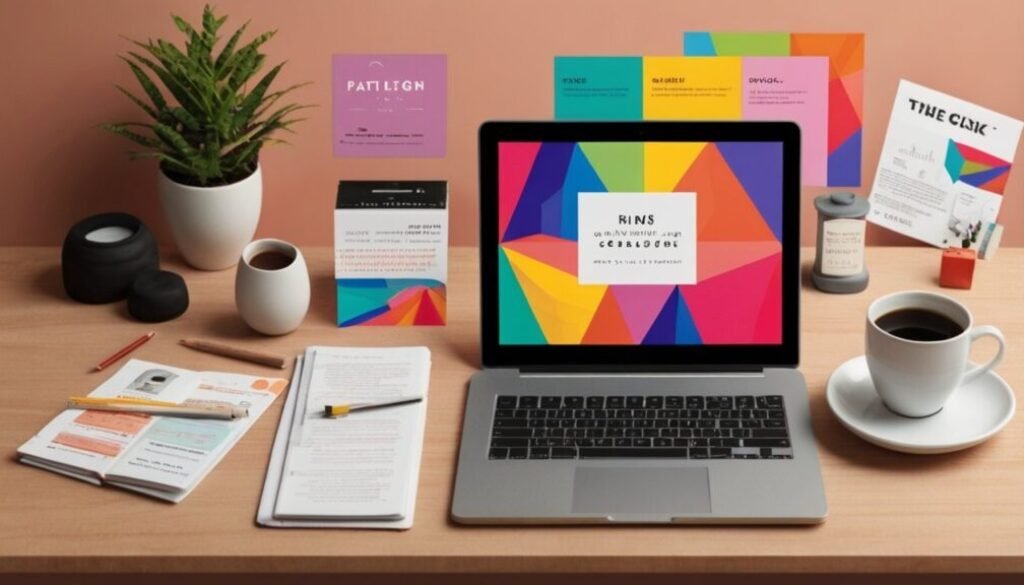How to Make a Book Cover: Beginner’s Step-by-Step Guide
Ever wondered how to make a book cover that actually grabs attention—and sells? Whether you’re self-publishing your first novel or creating an eBook for your business, your cover design can make or break a reader’s first impression. And with so many titles competing for clicks and shelf space, having a professional-looking book cover isn’t optional—it’s essential.
Knowing how to make a book cover that reflects your story and resonates with your target audience can set you apart in a crowded market. The good news? You don’t need to be a graphic designer to pull it off. With user-friendly tools like Canva and BookBrush, creating a high-quality book cover is more accessible than ever.
In this guide, you’ll learn everything from choosing the right dimensions and fonts to using the best book cover maker tools available. Ready to turn your manuscript into something that looks as good as it reads? Let’s dive in.

🧠 Chapter 1: Why Your Book Cover Matters
📌 Why Learning How to Make a Book Cover Is Critical for First Impressions
You’ve heard the phrase “don’t judge a book by its cover.” Unfortunately, most people do. In fact, a study published in the journal Psychological Science shows that we form first impressions in as little as 50 milliseconds—even for objects like books or websites (Willis & Todorov, 2006). If you’re self-publishing, knowing how to make a book cover that grabs attention can be the difference between clicks and crickets.
Book covers don’t just represent your story—they sell your story. Before anyone reads your blurb or checks reviews, your cover is the first conversion point.
🎯 The Psychology Behind Book Covers
Design psychology shows that:
-
Color affects emotional response: Warm colors evoke urgency; cool tones suggest trust and calm. This is essential when choosing a palette.
-
Font influences perception: Serif fonts feel traditional; sans-serif reads modern. Script fonts suggest emotion or luxury.
According to a report from Design Council UK, consistent branding (including visual design) can increase revenue by up to 23%. For indie authors or self-publishers, that’s a huge opportunity.
⚖️ Pros and Cons of DIY vs. Hiring a Designer
Knowing how to make a book cover yourself vs. outsourcing? Here’s a breakdown:
✅ DIY Cover Design (Pros & Cons)
Pros:
-
Budget-friendly
-
Full creative control
-
Fast iterations
Cons:
-
Risk of looking amateur
-
Lack of design psychology knowledge
-
Steeper learning curve for tools
✅ Professional Designer (Pros & Cons)
Pros:
-
Polished, market-ready visuals
-
Experience with genre-specific trends
-
Can align with brand strategy
Cons:
-
Cost ($50–$500+)
-
Revision limits
-
Time delays
Looking to hire a pro? Check out Top Fiverr Experts for Book Cover Design — this guide breaks down costs and how to get quality work.
🧩 How Book Covers Influence Buyer Behavior
Multiple studies, including one by Nielsen Book Research, found that cover design is the #1 reason browsers decide whether to read a product page. The more aligned your cover is with audience expectations, the more likely it is to convert browsers into buyers.
In other words, a book cover isn’t just decoration—it’s a sales funnel entry point.
Here’s how a strong cover helps:
-
Boosts discoverability: Strong thumbnails stand out on Amazon and social media.
-
Builds trust: Professional visuals make you look like a serious author or brand.
-
Reduces bounce: Readers stay longer when design aligns with their expectations.
Need to brush up on branding? See What Is a Brand Style Guide? Everything You Need to Know.
💡Evidence-Based Tips for Beginners on How to Make a Book Cover
If you’re going the DIY route, follow these science-backed, reader-tested tips:
✅ Use High-Contrast Elements
Why: Increases readability in thumbnails.
Tool: Canva’s built-in contrast checker
✅ Match Genre Conventions
Why: Readers are conditioned to expect certain visual cues in romance, horror, or fantasy books.
✅ Limit Fonts to Two
Why: Too many fonts reduce legibility and create chaos in layout.
✅ A/B Test Your Designs
Why: Tools like PickFu or Facebook Ad variations can help you test which cover gets the most engagement—critical before launch.
🔗Internal & Affiliate Links to Boost Your Cover Creation Journey
-
Want to make your own avatar or icon for the cover? Here’s how to create AI avatars + top Fiverr designers.
-
Building a whole brand? Don’t miss the ultimate guide to content for your website.
-
Looking for an affordable book designer? Browse verified gigs here on Fiverr (affiliate link).
🧭 Final Thoughts: Start With Intent, Not Just Aesthetics
If you only remember one thing from this chapter, let it be this: learning how to make a book cover is less about making something pretty and more about making something purposeful. A well-designed cover tells readers: this book is worth your time.
In the next section, we’ll dive deeper into the anatomy of a great book cover—what to include, what to avoid, and how to align every element with your message.
🎨 Want a pro-looking book cover but not ready to DIY?
You don’t have to start from scratch—you can hire a professional designer on Fiverr to create a polished, eye-catching cover that matches your book’s tone and genre.
👉 Click here to check out this top-rated book cover designer and get a custom design that sells.
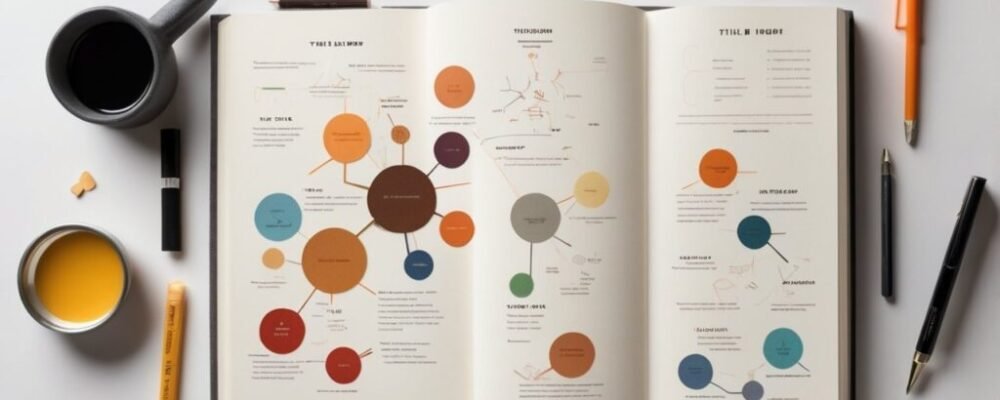
🎨 Chapter 2: What Makes a Great Book Cover
🧠Understanding How to Make a Book Cover That Sells
A great book cover doesn’t just look good — it works hard. It captures attention, conveys genre, and compels clicks. Whether you’re self-publishing your first novel or launching a non-fiction brand-builder, understanding how to make a book cover that delivers both visually and psychologically is essential.
According to a study published in PLOS ONE, visual appeal strongly influences consumer decision-making — even when it’s not directly related to product quality (Milosavljevic et al., 2012). That means even a brilliant story can be ignored if its packaging feels off.
So what makes a cover not just “good,” but great? Let’s break it down.
🧩The Core Elements of a Great Book Cover Design
📚 Genre Alignment Is Non-Negotiable
Your book cover must instantly signal its genre. This isn’t just branding — it’s cognitive pattern recognition.
Examples:
-
Romance → Soft fonts, pastel or rich color palettes, character imagery
-
Thriller → Dark tones, sharp typography, high-contrast imagery
-
Self-help → Clean, bold titles, minimal backgrounds, strong color use
Readers subconsciously associate these visual cues with the type of story they’re about to experience. Deviate too far, and you risk losing your audience before they even read the blurb.
🔗 Related: 25 Questions to Ask a Web Designer Before Hiring — also applies when choosing a book cover designer.
🔠 Typography That Communicates More Than Words
Typography on a book cover does two jobs:
-
Communicates the title and author name
-
Visually reflects tone, genre, and brand
Pro tips:
-
Use hierarchy: Make the title the hero.
-
Avoid more than 2 font families.
-
Choose readable fonts at small sizes, especially for eBook thumbnails.
💡 Want your fonts to match your branding? Learn how in What Is a Brand Style Guide?
🎨Color Psychology Drives Engagement
Colors affect emotions — and decisions. The Journal of the Academy of Marketing Science reports that color increases brand recognition by up to 80% (Labrecque & Milne, 2012).
Here’s a quick breakdown of genre-matched color choices:
| Genre | Common Colors | Emotional Effect |
|---|---|---|
| Horror | Black, red, gray | Fear, suspense |
| Romance | Pink, red, purple | Love, passion, warmth |
| Non-fiction | Blue, white, yellow | Clarity, trust, optimism |
| Fantasy | Gold, green, violet | Wonder, mysticism, magic |
Recommendation: Choose 1–2 dominant colors and 1 accent. Use tools like Coolors to build your palette.
⚖️How to Make a Book Cover That Balances Creativity and Strategy
🧩Balance Visuals With White Space
Cramming your cover with too many images or text? You’ll likely overwhelm readers. Strategic white space improves readability and elegance.
Tip: Think billboard, not brochure. Your book should “speak” at a glance.
🧰Use Professional Tools for Layout and Export
If you’re designing the cover yourself, these tools strike the best balance of power and ease:
-
✅ Canva (free + pro) – drag-and-drop with book cover templates
🔗 Try Canva Pro Templates on Fiverr (affiliate link) -
✅ BookBrush – built specifically for authors
-
✅ Adobe Express – clean, minimal designs with pro controls
Looking for help? Here’s a list of top-rated Fiverr design pros for any budget.
💥Real-World Examples of Great Book Covers
Let’s analyze three real covers across genres — and why they work.
Fiction: The Midnight Library by Matt Haig
-
Minimalist grid design = curiosity
-
Deep blue + yellow = mystery & hope
-
Serif font = literary tone
Non-fiction: Atomic Habits by James Clear
-
White background = clarity
-
Textured typography = transformation theme
-
Bold hierarchy = instant impact
Self-Published Romance: Love in the Time of Serial Killers by Alicia Thompson
-
Playful typography + weapon icon = contrast and intrigue
-
Soft pink background = unexpected twist on genre tropes
📌 Want to design your own viral cover? Try this AI avatar + design guide
✅ Key Takeaways for Designing a Great Book Cover
-
Know your genre conventions
-
Choose fonts and colors that match your message
-
Keep the layout clean and thumbnail-friendly
-
Test multiple versions if possible
-
Use professional tools or hire a vetted designer
🔗 Continue Reading
📚 Cited Sources:
-
Milosavljevic, M., Navalpakkam, V., Koch, C., & Rangel, A. (2012). PLOS ONE. https://doi.org/10.1371/journal.pone.0040367
-
Labrecque, L. I., & Milne, G. R. (2012). Journal of the Academy of Marketing Science. https://doi.org/10.1007/s11747-011-0272-6
Not a designer? No stress.
If you’d rather focus on writing and let someone else handle the visuals, Fiverr has book cover designers who can do it all for you.
👉 Check out this pro designer here —fast turnaround, clean style, totally worth it.

🛠️ Chapter 3: Tools to Create a Book Cover (No Design Skills Needed)
🧠 The Easiest Way to Learn How to Make a Book Cover — Use the Right Tools
Designing your own book cover used to mean expensive software and steep learning curves. But not anymore. Thanks to intuitive online platforms, you can learn how to make a book cover in minutes—even with zero design background.
These tools come loaded with templates, drag-and-drop interfaces, and features made for non-designers. They remove the guesswork, lower your costs, and get you results fast.
In this chapter, we’ll compare the top 3 beginner-friendly book cover makers, break down their pros and cons, and help you choose the one that fits your goals, genre, and budget.
🖥️ Best Tools for Beginners Learning How to Make a Book Cover
🧩 1. Canva – The Most Popular DIY Design Tool
Why it’s great for book covers:
Canva’s drag-and-drop interface, paired with thousands of templates, makes it a go-to for authors and marketers alike.
Key Features:
-
250+ book cover templates
-
Custom dimensions for eBooks and print
-
Free plan available (Pro unlocks more fonts & assets)
-
Built-in stock photo access
Pros:
-
Extremely easy to use
-
Free version is generous
-
Great for testing multiple designs fast
Cons:
-
Templates may look generic if not customized
-
Some assets require Canva Pro
🔗 Want designer-level templates without doing the work?
→ Hire a Canva expert on Fiverr (affiliate) to customize your book cover for under $50.
🎨2. BookBrush – Built Specifically for Authors
If you want a tool designed exclusively for authors, BookBrush is your answer.
Key Features:
-
Genre-specific templates
-
3D cover mockups for marketing
-
Easy export for KDP & IngramSpark
-
Community templates (romance, thriller, fantasy, etc.)
Pros:
-
Made for writers — no fluff
-
Includes marketing image templates (great for social media)
-
Handles print + eBook formats
Cons:
-
No free plan (limited free trial only)
-
Less flexible for non-book projects
📌 Pro Tip: BookBrush also includes promotional tools to help you showcase your cover on devices, 3D mockups, and ad-style layouts.
🧠3. Adobe Express – Clean, Brand-Focused Designs
Looking for something a little more refined and less templated? Adobe Express is a good middle ground between Canva and Photoshop.
Key Features:
-
Elegant, minimalistic templates
-
Adobe Fonts access
-
Cross-platform (desktop & mobile)
-
Brand kit tools for consistent visuals
Pros:
-
Sophisticated look
-
Perfect for non-fiction, business, or thought leadership books
-
Free plan includes Adobe-quality templates
Cons:
-
Smaller template library compared to Canva
-
Slightly steeper learning curve
👉 Bonus: Adobe Express integrates well with other Adobe apps if you ever scale up to InDesign or Photoshop later.
⚖️Canva vs. BookBrush vs. Adobe Express – Comparison Table
| Feature | Canva | BookBrush | Adobe Express |
|---|---|---|---|
| Ease of Use | ⭐⭐⭐⭐⭐ | ⭐⭐⭐⭐ | ⭐⭐⭐⭐ |
| Best For | All genres | Authors only | Non-fiction, business |
| Templates | 250+ | Genre-specific | Sleek + minimal |
| Free Version | ✅ | ❌ (trial only) | ✅ |
| 3D Mockups | ❌ (via plugins) | ✅ | ❌ |
| Export for Print | ✅ | ✅ | ✅ |
| Affiliate Option | Fiverr Canva Experts | Hire BookBrush Designers | Adobe Express Templates |
🧪 What Science Says About Design Simplicity
Good design isn’t about making something fancy — it’s about making something functional.
According to research published in Behavior and Information Technology, users form trust and preference judgments about a site or image in under 0.1 seconds, and simpler designs are perceived as more trustworthy (Tuch et al., 2012).
That’s why these tools, with their pre-optimized templates and clean layouts, help you create covers that not only look good — but perform.
💡How to Choose the Right Tool Based on Your Book
If you’re writing…
-
Fiction / genre-driven books → BookBrush
-
Business / non-fiction / personal branding → Adobe Express
-
Anything & want fast results on a budget → Canva
Still unsure? Try a few free versions and test 1–2 cover designs with readers or Facebook ads before committing.
🧭 Need Help Bringing Your Cover to Life?
Design not your thing? You can still get a stunning cover by hiring a vetted Fiverr freelancer.
🔗 Explore:
Or browse Fiverr’s curated book cover gigs here (affiliate).
✅ Summary: Which Tool Is Best for How to Make a Book Cover?
-
Use Canva if you want fast, flexible, and free.
-
Choose BookBrush if you want author-specific templates and marketing assets.
-
Try Adobe Express for sleek, professional non-fiction branding.
At the end of the day, your book cover is your first impression. These tools help you make it count—without the stress or cost of hiring a full design team.
You poured your heart into writing—don’t let a weak cover hold it back.
A professionally designed book cover tells readers, this is worth reading.
👉 Hire this expert on Fiverr and give your story the cover it deserves.
📚 Scientific Sources:
-
Tuch, A. N., Bargas-Avila, J. A., Opwis, K., & Wilhelm, F. H. (2012). Visual complexity of websites: Effects on users’ experience, physiology, performance, and memory. https://doi.org/10.1080/0144929X.2012.681277
-
Milosavljevic, M. et al. (2012). Influence of visual marketing on rapid choice decisions. https://doi.org/10.1371/journal.pone.0040367

🧭 Chapter 4: Step-by-Step — How to Make a Book Cover
Creating a compelling book cover isn’t about throwing some text over a stock image. It’s a process — and a strategic one. Whether you’re writing fiction, nonfiction, or a digital short story, understanding each phase of how to make a book cover gives you control over how your book is perceived and how well it sells.
This chapter walks you through the full design process, with tool recommendations and insider tips to help your cover stand out on digital shelves and print displays.
🪞 Step 1 — Define Your Target Reader Before You Design
Before opening Canva or BookBrush, ask:
Who am I designing this for?
Your target reader determines:
-
The visual style (serious, playful, mysterious)
-
The color palette (calm blues vs. intense reds)
-
The font and title hierarchy
🎯 Example: Designing a book for young adult fantasy readers? You’ll want bold, magical imagery, rich jewel tones, and strong serif typography.
If you skip this step, you risk designing something pretty — but irrelevant.
🔗 Related: What Should You Put on a Website? Key Tips & Best Practices
📐 Step 2 — Choose the Right Dimensions and Format
Understanding the technical requirements of your publishing platform is crucial.
For Amazon Kindle (KDP):
-
Ideal size: 2,560 x 1,600 px
-
Ratio: 1.6:1
-
File type: JPG or TIFF
-
Max file size: 50MB
For Print Books:
-
Check trim size (e.g., 6″ x 9″)
-
Include bleed if full-bleed printing
-
Use CMYK color mode
📌 Tools like Canva and Adobe Express offer preset sizes for Kindle, IngramSpark, and paperback layouts.
🔗 Need help exporting to the right format? Hire a Fiverr designer who specializes in KDP covers (affiliate).
🎨 Step 3 — Select a Template or Start from Scratch
If you’re a beginner, start with a template. It saves time and offers a proven layout.
Where to find professional templates:
-
✅ Canva: Browse templates
-
✅ BookBrush: Genre-based layouts
-
✅ Adobe Express: Minimalist, elegant designs
Tips:
-
Remove or customize stock images and fonts to avoid generic results
-
Keep your layout clean — one focal point per cover
-
Ensure text placement doesn’t clash with busy backgrounds
🛑 Don’t use overused templates without editing. Readers can spot a “template cover” instantly, and it can hurt your credibility.
✍️ Step 4 — Add Your Book Title, Subtitle, and Author Name
This is where clarity meets creativity. Here’s how to do it right:
Hierarchy:
-
Title should be largest and most readable
-
Subtitle is optional but helpful for non-fiction
-
Author name goes at the bottom or top, depending on visual balance
Typography Tips:
-
Use serif fonts for tradition, sans-serif for modern tone
-
Avoid novelty fonts (unless genre-appropriate)
-
Ensure readability in thumbnail view
📌 Pro Tip: Use Adobe Fonts or Google Fonts to find high-quality, free-use typefaces.
🖼️ Step 5 — Add and Adjust Your Visual Elements
Strong covers balance imagery with negative space. You can use:
-
High-res stock photos (via Canva, Unsplash, or Pixabay)
-
Illustrations (AI-generated or commissioned)
-
Abstract textures for non-fiction
Key Design Practices:
-
Stick to a limited color palette
-
Maintain alignment and spacing
-
Use drop shadows or blurs to improve contrast
🎨 Want custom graphics? Try this Fiverr gig for affordable illustrations (affiliate) tailored to your theme.
📦 Step 6 — Export Your Book Cover for Print & Digital Use
Each platform has different requirements. Export with these best practices:
eBook:
-
JPG format
-
72–300 DPI resolution
-
RGB color mode
Print:
-
PDF format
-
300 DPI resolution
-
CMYK color mode
-
Include spine width and back cover if using a wraparound
Use tools like KDP Cover Calculator to get your exact dimensions.
🔗 Looking for a pro to finalize your files? Check out the Top Fiverr Cover Format Experts
⚠️ Common Pitfalls to Avoid When Learning How to Make a Book Cover
-
❌ Using low-res or stretched images
-
❌ Ignoring genre design conventions
-
❌ Overcomplicating layout with too much text
-
❌ Choosing fonts that are hard to read on small screens
📌 Quick Fix: Use a 3D mockup viewer to preview your design as a thumbnail and in print.
🎯 Summary: Your Book Cover Design Checklist
Here’s a quick-reference checklist to keep you on track:
✅ Define your audience
✅ Set correct dimensions
✅ Use a template or start clean
✅ Add clean, legible text hierarchy
✅ Select strong visuals that align with your genre
✅ Export for the right platforms (eBook vs print)
Want the printable version? Download our Free Book Cover Checklist PDF (coming soon)
🔗 Internal Links to Continue Your Journey
📚 Scientific Insight:
Research from User Experience Magazine notes that visual hierarchy and spacing in design directly influence readability and user retention. (Source: UXPA.org, 2020)
Not great with design tools? Totally fine.
You don’t need Photoshop skills to get a pro-level book cover.
👉 This Fiverr designer can turn your idea into something you’ll actually want to publish.

📚 Chapter 5: Examples of Great Book Covers — What Works and Why
🎯 Learning How to Make a Book Cover by Studying the Best
The fastest way to understand how to make a book cover that works? Study covers that already do.
Analyzing successful book covers reveals what readers respond to, what design choices reinforce genre expectations, and how small tweaks can lead to big conversion gains. In this chapter, we’ll break down examples across key genres—fiction, non-fiction, indie, and even self-published standouts.
Whether you’re designing your own or hiring a pro, these breakdowns will give you a sharper eye for detail and a clearer direction for your own cover.
🧙♂️ Fiction Book Covers — Create Mood at a Glance
📘 The Night Circus by Erin Morgenstern
Why it works:
-
Monochrome color scheme + splash of red = immediate intrigue
-
Delicate serif font = literary tone
-
Intricate illustration = fantasy + historical depth
Design Takeaway:
Use limited color palettes to highlight mood, and detailed graphics to suggest plot tone.
📌 Tools used: Adobe Illustrator, custom typography
🎨 Try Fiverr for custom fantasy cover illustrations (affiliate).
📙 Where the Crawdads Sing by Delia Owens
Why it works:
-
Soft, pastel imagery = emotional tone
-
Sans-serif title = contemporary feel
-
Clear author branding = strong shelf presence
Design Takeaway:
Don’t overdesign. Let nature imagery + clean typography do the emotional work.
🔗 Related: Top Fiverr Designers for Book Covers
💼 Non-Fiction Book Covers — Clarity, Trust, Authority
📕 Atomic Habits by James Clear
Why it works:
-
Minimalist white cover = clarity, authority
-
Gold dust texture = transformation
-
Title is ultra-legible at thumbnail size
Design Takeaway:
For non-fiction, simplicity sells. Use space strategically and let bold titles drive the eye.
📌 Design Tool: Canva Pro or Adobe Express
🛠️ Hire designers who specialize in minimalist non-fiction on Fiverr
📗 Dare to Lead by Brené Brown
Why it works:
-
Cool blue tones = trust, leadership
-
Lowercase font = approachability
-
Subtitle positioning adds rhythm and white space balance
Design Takeaway:
Align color psychology with the theme of your message. Balance authority with empathy.
📌 Related: What Is a Brand Style Guide?
🧠 Indie & Self-Published Covers — Small Budget, Big Impact
📔 Love in the Time of Serial Killers by Alicia Thompson
Why it works:
-
Playful contrast: romantic fonts + murder weapon icon
-
Soft pink background = unexpected for thriller-romance
-
Bold title structure = scroll-stopping
Design Takeaway:
Play with expectations—juxtaposing genre elements can create intrigue and memorability.
🔗 Want bold, genre-bending visuals? Try AI art + expert layout pairing
📓 The Subtle Art of Not Giving a Fck* by Mark Manson
Why it works:
-
Loud orange = disruption
-
Sans-serif caps = no-nonsense tone
-
Title size and swear word = attitude and authority
Design Takeaway:
Sometimes bold color + blunt language is all you need. Let tone dictate your design.
🎨 Genre-by-Genre Quick Visual Tips
| Genre | Visual Cues | Font Style | Color Palettes |
|---|---|---|---|
| Romance | Characters, soft-focus, warm light | Script/serif | Pink, red, cream |
| Thriller | High contrast, shadows, urban textures | Bold sans-serif | Black, red, gray |
| Fantasy | Symbols, magic effects, elaborate scenes | Serif or gothic | Purple, gold, green |
| Business | Icons, clean lines, minimalist grids | Sans-serif | Blue, white, gray |
| Self-Help | Emotive typography, bold titles | Sans-serif | Yellow, black, white |
📌 Need pre-designed genre-specific templates?
Explore BookBrush genre templates (affiliate).
📏 How to Apply These Lessons to Your Own Cover
Here’s how to adapt what you’ve learned:
-
Identify your genre and decode its design patterns.
-
Compare top-selling books in your category.
-
Mock up 2–3 design styles using Canva or BookBrush.
-
Test designs with readers or social polls.
-
Iterate based on feedback.
🔗 Related: Article vs Blog Post – Choosing the Right Format
✅ Summary: Studying the Best to Design Your Best
You don’t need to reinvent the wheel to learn how to make a book cover that works. You just need to study what readers already respond to—and blend that insight with your story’s unique voice.
Use real-world examples as your north star. Learn the rules of your genre. Then, make intentional choices about what to follow—and what to break.
Up next: We’ll cover expert tips for A/B testing and finalizing your book cover before launch.
A great book cover can boost clicks, downloads, and trust—especially on platforms like Amazon.
Instead of guessing your way through Canva, why not let a pro design it for you?
👉 Check out this experienced book cover designer on Fiverr
📚 Bonus Resources:

🧠 Chapter 6: Final Tips for Creating a Winning Book Cover
🎯 You’ve Learned How to Make a Book Cover — Now Make It Exceptional
By now, you understand the strategy, the structure, and the tools behind how to make a book cover that gets noticed. But before you hit “publish” or upload to Amazon, let’s fine-tune your design for impact, clarity, and performance.
The best book covers don’t just look good—they convert. They connect emotionally, stop the scroll, and invite readers to explore more.
Here are the final, essential steps to ensure your book cover stands out in a crowded market.
📊 Test Your Book Cover Before Publishing
Designing in isolation is risky. Your ideal reader’s opinion matters more than your own.
✅ Why Testing Matters:
According to Harvard Business Review, A/B testing visual creatives can increase conversions by up to 40% depending on the platform and audience segmentation.
🔧 How to A/B Test a Book Cover:
-
Facebook or Instagram ads: Show two variations, track clicks.
-
Reader polls: Use platforms like PickFu or your author newsletter.
-
Beta reader group feedback: Ask for first-impression scores (1–10 scale).
🔗 Related: Top Fiverr Experts to Help You Test + Format Your Cover
🎨 Keep the Thumbnail Test in Mind
Most of your readers will see your book as a 120px thumbnail before anything else.
📌 Ask yourself:
-
Is the title legible at small size?
-
Does the cover still “pop” in grayscale?
-
Is the genre obvious without reading the text?
🧪 Pro Tip: Zoom out on your cover preview to 10–15% and judge it on impact alone.
🧠 Use Emotion, Not Just Aesthetics
Design should feel like the story.
✅ Genre Emotion Examples:
-
Romance: Intimacy, tension, warmth
-
Horror: Fear, unease, curiosity
-
Self-help: Transformation, control, motivation
If your book cover doesn’t reflect the emotional arc of your content, you’re missing a conversion trigger.
🎯 Want help? Hire an artist to capture mood via AI-generated or hand-illustrated covers (affiliate)
📋 Run Your Final Cover Through This Pre-Publish Checklist
Here’s a quick filter to validate your cover before launch:
| ✅ Task | Description |
|---|---|
| ✔ Title is readable in thumbnail? | Yes / No |
| ✔ Design aligns with genre? | Yes / No |
| ✔ Font usage is consistent and clean? | Yes / No |
| ✔ Colors evoke intended emotion? | Yes / No |
| ✔ Image resolution is 300 DPI? | Yes / No |
| ✔ Export formats match platform (PDF for print, JPG for eBook)? | Yes / No |
| ✔ Back cover + spine are included (if printing)? | Yes / No |
📄 Want this as a PDF? A downloadable Cover Design Checklist is coming soon.
🧩 Bonus Pro Tips From Top Designers
We spoke with several Fiverr book cover experts to compile these top-level insights:
-
“White space isn’t empty—it’s power. Use it to frame your message.”
-
“Use genre tropes, but break one rule. That’s how you stand out.”
-
“Never rely on one version. Always mock up at least three designs.”
🔗 Related reading: 25 Questions to Ask a Designer Before Hiring
🌍 Future-Proof Your Book Cover for Multiple Platforms
Publishing wide? Your cover needs to adapt.
| Platform | Requirements |
|---|---|
| KDP | 2,560 x 1,600 px (JPG, RGB) |
| IngramSpark | PDF, 300 DPI, includes full spine and bleed |
| Apple Books | Clean minimalist design, center-focused text |
| Audible | Square format (2400 x 2400 px), simpler typography |
📌 Need all versions exported correctly? Use Fiverr formatting services (affiliate)
🔗 Keep Building Your Author Brand
Your cover is only the beginning. Want to build momentum post-launch?
✅ Summary: Making a Winning Cover Is a System, Not a Guess
Now you know how to make a book cover that doesn’t just sit pretty—but sells. From understanding your audience, choosing the right tools, following genre signals, testing real responses, and exporting for every platform—you’ve got the full toolkit.
Keep designing, keep testing, and keep learning from what works. Because the best covers aren’t lucky—they’re intentional.
Not great with design tools? Totally fine.
You don’t need Photoshop skills to get a pro-level book cover.
👉 This Fiverr designer can turn your idea into something you’ll actually want to publish.
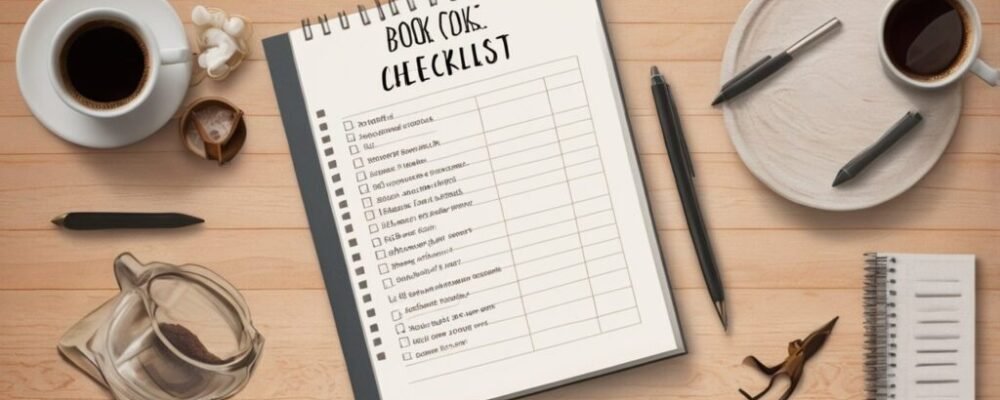
🏁 Conclusion: You Now Know How to Make a Book Cover That Works
If you’ve made it this far, you’re no longer guessing your way through cover design—you’ve learned how to make a book cover that’s strategic, genre-appropriate, and emotionally engaging.
Let’s recap the essentials:
✅ What You’ve Learned
-
Why your book cover matters — it’s your first impression and your silent salesperson.
-
What makes a cover great — visual hierarchy, genre alignment, and emotional clarity.
-
Which tools help — Canva, BookBrush, Adobe Express, and Fiverr designers.
-
The step-by-step process — from defining your audience to exporting the final files.
-
How to analyze great covers — and apply those techniques to your own.
-
Final polish — testing, thumbnail checks, formatting, and expert insights.
This wasn’t just theory—it’s a roadmap for anyone serious about building a brand, selling more books, or simply standing out.
💡 Final Thought: Don’t Just Design—Communicate
A good book cover doesn’t try to say everything. It says one thing, clearly and powerfully, to the right person. That’s what moves a reader from “scroll” to “click” to “buy.”
So as you put your new skills to work, keep your reader at the center. Your cover should reflect what they need to feel—not just what you want to show.
🔗 Keep Growing: Next Steps
Whether you’re launching your first book or refining your tenth, here’s what to do next:
-
✅ Hire a vetted book cover designer on Fiverr (affiliate)
📥 Bonus: Want the Full Checklist?
Stay tuned for our downloadable Book Cover Design Checklist PDF — or drop your email below to get early access (optional CTA).
🖼️ Ready to Visualize?
We can even generate custom AI visuals of your book cover idea. Just tell us the vibe, genre, and title — and we’ll help you bring it to life. Need that next?
🎉 Congrats — You Now Know How to Make a Book Cover Like a Pro.
Go from writer to visual storyteller. Your audience is waiting—make that first glance count.
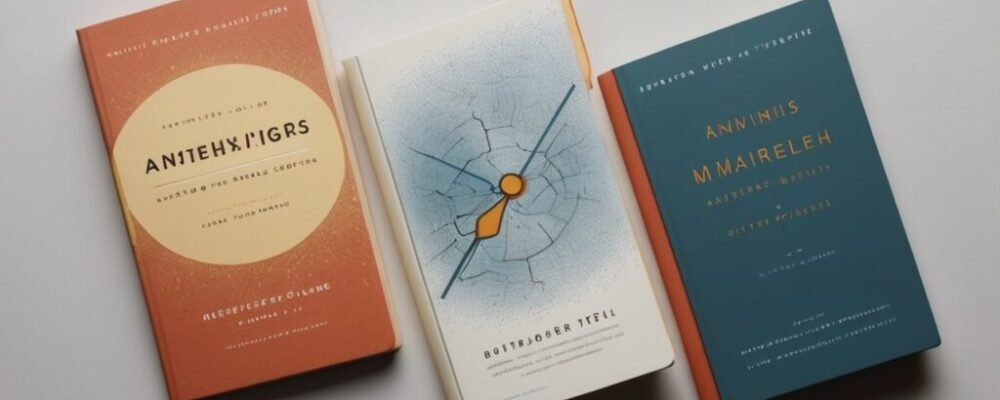
Top 10 Fiverr Experts You Can Trust to Elevate Your Project
Carefully vetted freelancers for book covers, branding, websites, and more.
1 Hmdpublishing
I’m a professional book cover designer creating striking, market-ready covers for fiction and nonfiction. Skilled in typography, layout, and image compositing, I deliver Kindle/KDP and print-ready files (front, spine, back) at 300 DPI. Collaborative, fast, and detail-oriented, I turn your brief into a cover that sells and fits your genre.
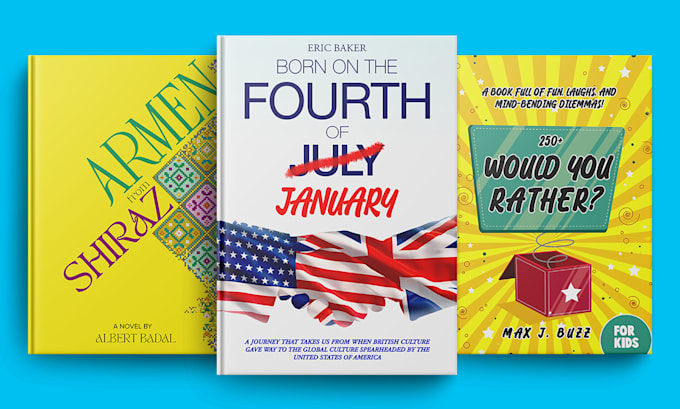


2 David
I’m a professional book cover designer and art director crafting cinematic, genre-accurate visuals for print and eBooks. Expert in typography, composition, and image grading, I deliver KDP/Ingram-ready files at 300 DPI. Collaborative and fast, I translate briefs into striking, marketable covers that sell—on-brand, on-time, and press-perfect, with revisions and support.

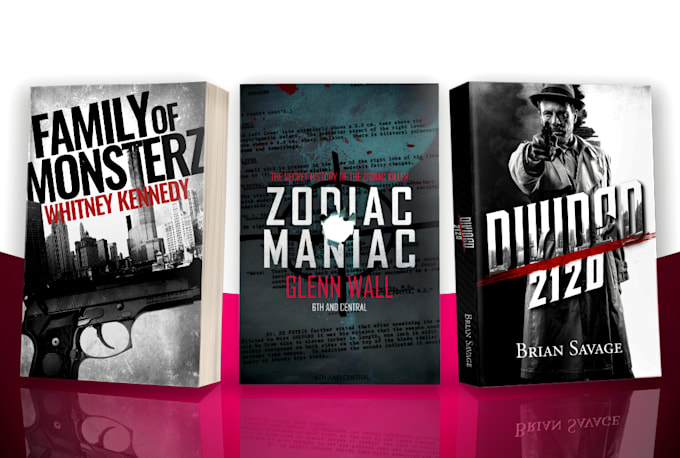

3 Andriy D
I’m an award-winning book cover illustrator with a distinctive, original style. I combine bold composition, expressive typography, and cinematic color to craft genre-accurate, beautiful covers that sell. KDP/Ingram-ready, 300-DPI print and eBook files included. Collaborative and detail-driven, I offer concept sketches, revisions, and art direction to bring your story alive.
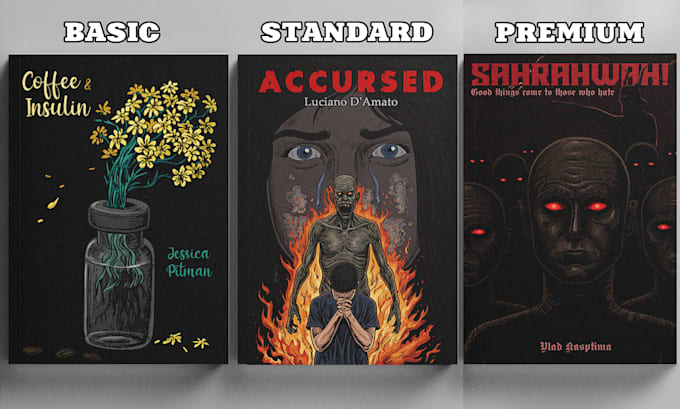
4 Lena S.
I’m a professional book cover designer known for vibrant, color-rich compositions that sell. Combining bold typography, balanced layout, and expressive illustration, I create KDP/Ingram-ready covers at 300 DPI for fiction and nonfiction. Collaborative and detail-oriented, I turn briefs into standout, on-brand artwork—delivered fast, print-ready, with thoughtful revisions included.
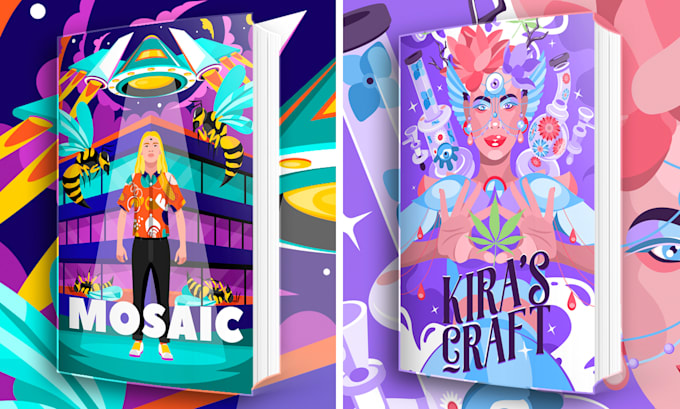
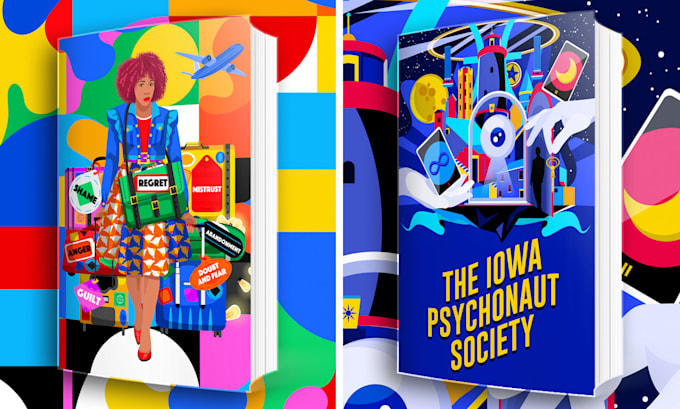

5 Marko M.
I’m a professional book cover designer delivering unique, market-ready covers for fiction and nonfiction. I blend compelling typography, composition, and color grading to match your genre and audience. KDP/Ingram-compliant, 300-DPI print and eBook files included. Collaborative, fast, and detail-obsessed, I transform briefs into striking covers that sell—on time, reliably.



6 noemidefeo
I’m a cookbook illustrator bringing recipes to life with mouth-watering visuals. From watercolor and ink to crisp vector art, I create step-by-step how-tos, ingredient spots, and full spreads. Print-ready (CMYK, 300 DPI) for KDP/Ingram. Style-matched, detail-driven, and deadline-reliable—delivering appetizing, brand-consistent artwork that makes readers want to cook.
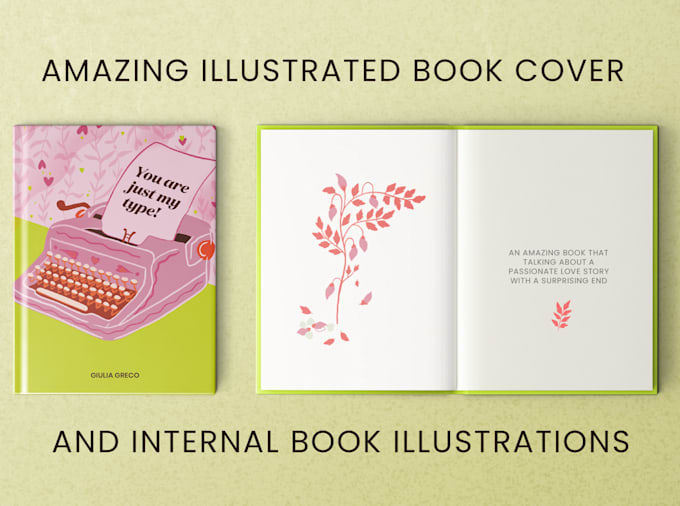

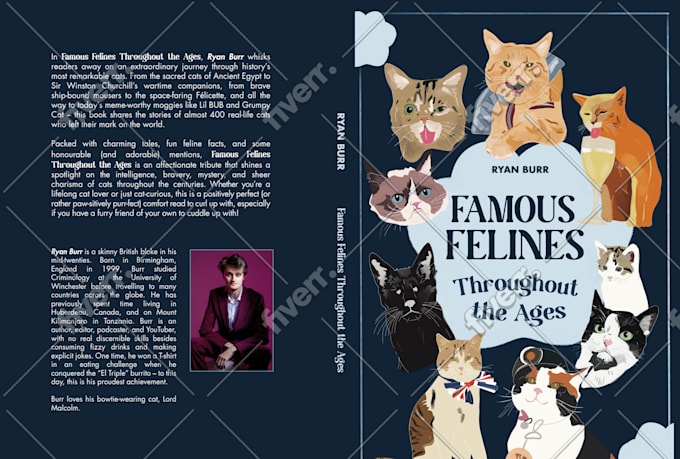
7 Priyantha D
I’m a professional book cover designer specializing in market-ready covers for fiction and nonfiction. I blend bold typography, balanced layout, and compelling imagery to match your genre and audience. KDP/Ingram compliant, print and eBook ready at 300 DPI. Fast, collaborative, and detail-driven, I deliver covers that sell consistently, on time.



8 Matteo G.
I’m a vector art book cover designer crafting clean, scalable designs with bold typography and striking color. Skilled in Adobe Illustrator and InDesign, I deliver KDP/Ingram-ready files at 300 DPI. Collaborative and deadline-driven, I translate your brief into marketable, genre-accurate covers that stand out online and on shelves consistently worldwide.



9 Andrea D.
I’m a professional eBook cover designer crafting genre-accurate, high-converting covers. Skilled in typography, composition, and image compositing, I deliver KDP/Ingram-ready files at 300 DPI for Kindle and print. Collaborative, detail-driven, and fast, I translate briefs into striking, on-brand artwork—with mockups, revisions, and press-perfect exports included.

10 Predrag M.
I’m a professional eBook cover designer crafting genre-accurate, high-converting covers. Skilled in typography, composition, and image compositing, I deliver KDP/Ingram-ready files at 300 DPI for Kindle and print. Collaborative, detail-driven, and fast, I translate briefs into striking, on-brand artwork—with mockups, revisions, and press-perfect exports included.

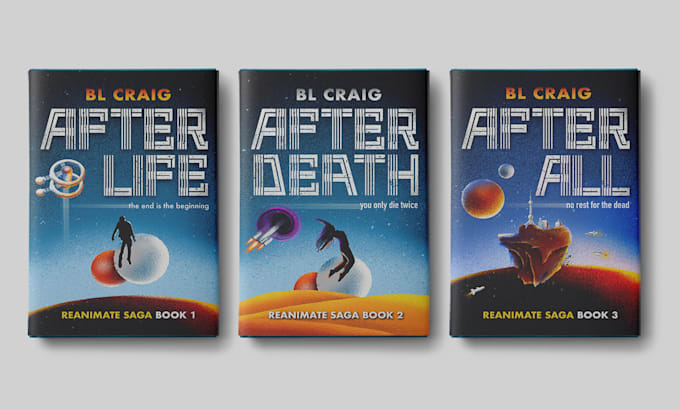

Please log in to access your exclusive content.
Don’t have an account? Click the “Register” button below to sign up.
